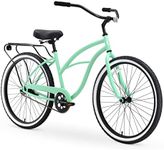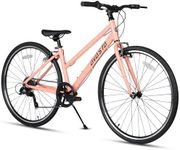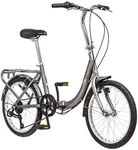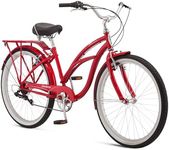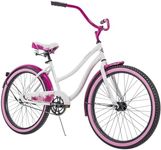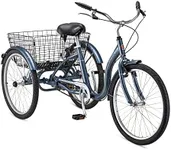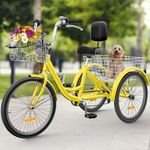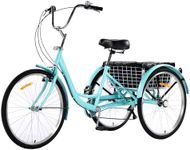Buying Guide for the Best Women's Bicycles
Choosing the right women's bicycle involves understanding your specific needs and preferences. Whether you're looking for a bike for commuting, fitness, leisure, or competitive cycling, there are several key specifications to consider. By understanding these specs, you can make an informed decision and find a bike that fits you perfectly. Here are the key specs to look at and how to navigate them.Frame MaterialThe frame material of a bicycle affects its weight, durability, and ride quality. Common materials include aluminum, steel, carbon fiber, and titanium. Aluminum is lightweight and affordable, making it a good choice for casual riders. Steel is heavier but offers a smooth ride and is very durable. Carbon fiber is very light and provides excellent performance, ideal for competitive cycling. Titanium is both light and strong but tends to be more expensive. Choose a frame material based on your riding style and how much weight and durability matter to you.
Bike TypeThere are various types of women's bicycles, each designed for different purposes. Road bikes are built for speed and long-distance riding on paved surfaces. Mountain bikes are designed for off-road trails and rough terrain. Hybrid bikes combine features of road and mountain bikes, making them versatile for both city commuting and light trail riding. Cruiser bikes are perfect for leisurely rides on flat terrain. Consider where and how you plan to ride most often to determine the best bike type for you.
Frame SizeThe frame size of a bicycle is crucial for comfort and efficiency. It is typically measured in inches or centimeters and corresponds to the length of the seat tube. To find the right frame size, you need to consider your height and inseam length. Most bike manufacturers provide size charts to help you choose the correct frame size. A properly sized bike will ensure a comfortable ride and reduce the risk of injury.
GearsGears on a bicycle help you manage different terrains and inclines. Bikes can have a wide range of gears, from single-speed to 30 or more gears. If you plan to ride on flat terrain, a bike with fewer gears may be sufficient. For hilly areas or varied terrain, more gears will make your ride easier and more efficient. Think about the terrain you'll be riding on and your fitness level to decide how many gears you need.
BrakesBrakes are essential for safety and control. The main types are rim brakes, disc brakes, and coaster brakes. Rim brakes are lightweight and easy to maintain, suitable for casual riding. Disc brakes offer better stopping power and performance in wet conditions, making them ideal for mountain biking and commuting. Coaster brakes are found on cruiser bikes and are activated by pedaling backward. Consider the type of riding you'll be doing and the conditions you'll encounter to choose the right brakes.
SuspensionSuspension systems on bicycles help absorb shocks from rough terrain, providing a smoother ride. There are front suspension (hardtail), full suspension, and no suspension options. Front suspension is common on mountain bikes and helps with control and comfort on trails. Full suspension bikes have both front and rear suspension, offering maximum comfort and control on very rough terrain. Bikes with no suspension are lighter and more efficient on smooth surfaces, making them ideal for road biking. Choose the suspension type based on the terrain you'll be riding on.
Fit and ComfortFit and comfort are paramount when choosing a bicycle. Women's bikes often have specific design features like a shorter top tube, narrower handlebars, and women's-specific saddles to enhance comfort. Test ride different bikes to see which one feels the most comfortable. Pay attention to the saddle, handlebar height, and reach to the handlebars. A bike that fits well will make your rides more enjoyable and reduce the risk of discomfort or injury.
